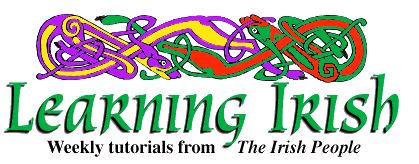
Irish Lesson 36
|
PRONUNCIATION EXERCISE Read this passage slowly without looking at the key below it. Then read it a second time, making use of the key if you are unsure. Do not try to make sense out of the words; concentrate on the pronunciation and on grouping the words into phrases. Chualamar faoi chluiche neamhghnách má thugtar cead a gcinn de fhoireann na hÉireann ag déanamh drochphoiblíochta den chinéal sin. Mheasamar go mbíonn an baile mór go minic ag labhairt le cuairteoirí, ach tá an teilifís san seol ina bhfuilimid ag maireachtáil san agéid cheadúnais mura musclaíonn tú lucht na Gaeilge. Is gnách go mbíonn moill bliana as gach cearn den domhan ag an té a fuair na himleabhair go léir. Key: K*OOL-uh-muhr fwee K*LI-he nyav-GNAW*K* maw* HUG-tuhr kad uh gin DIR-uhn nuh HAY*R-uhn uh DAY*N-uhv druhk*-FWIB-lee-uhk* tuh den HYIN-aw*l shin. VAS-uh-muhr goh MEE-uhn un BAHL-e mohr goh MIN-ik uh LOU-irt luh koo-ir-TYOH-ree, ahk* taw* un TEL-i-fees suhn shohl IN-uh VWIL-i-mid uh MAHR-uhk*-taw*-il suhn AH-gay*d hya-DOON-ish MU-ruh mus-KLEE-uhn too luk*t nuh GAY*-lig-e. is gnaw*k* goh MEE-uhn mwil BLEE-uh-nuh as gahk* kyarn den DOH-wuhn eg un tay* uh FOO-ir nuh him-LOU-ir goh lay*r.
GRAMMAR The Irish word "ar" (er) is part of expressions that correspond to "to wear" in English. For example: Tá hata ar Nóra; A hat is on Nora, Nora is wearing a hat. Tá léine (LAY*-ne) glan orm; I have a clean shirt on. Ní raibh cóta ná hata air; He wasn't wearing a coat or hat.
Illnesses and sleepiness can also be "ar" a person. Some examples: Tá tinneas cinn orm (TIN-yuhs kin OH-ruhm), I have a headache (lit.: sickness of head upon me). Nach raibh tinneas fiacaile ort? (nahk* rev TIN-yuhs FEE-kuh-le OH-ruht), Didn't you have a toothache? Bhí fiabhras orthu (vee FEE-vruhs OHR-huh), They had a fever. Tá codladh orm (taw* KUHL-uh OHR-ruhm) I am sleepy. "Ar" follows several verbs, in examples such as: Féach air! (FAY*-ahk* er), Look at him! Tosaigh air! (TUH-see air), Begin it! Glaoigh air! (GLAY*-ee er), Call him! Iarr leabhar air! (EER LOU-uhr er), Ask him for a book!
VOCABULARY The cardinal numbers, used only for cases where objects or persons are not mentioned, or for telling time: a haon (uh HAY*N), one a dó (uh DOH), two a trí (uh TREE), three a ceathair ( uh KA-hir), four a cúig(uh KOO-ig), five a sé (uh SHAY*), six a seacht (uh SHAHK*T), seven a hocht (uh HOHK*T), eight a naoi (uh NEE), nine a deich (uh DE), ten a haon-déag (uh HAY*N day*-uhg), eleven a dó-dhéag (a DOH yay*-uhg), twelve These numbers are for counting, as in "one, two, three, four", or for saying "Bus No. 5" or "Room No. 7". Also to answer the following question: Cé'n t-am é? (kay*n toum ay*), What time is it? Tá sé a dó a chlog (k*luhg), It is two o'clock. Do not use these numbers to say "three boxes" or "seven boys". Irish has other forms for these uses.
DRILL Count from "a haon" to "a dó-dhéag" until you can do it rapidly and in reverse order. Make use of these numbers during the day to read license plates, house numbers and signs, one numeral at a time. "Zero" is "nialas" (NEEL-uhs). Next, go through the progressive drills for the following:
CONVERSATION Siobhán (shi-VAW*N): Dia duit, a Chiaráin (DEE-uh git, uh hyir-AW*-in). Hello, Kieran. Ciarán (kir-AW*N): Dia's Muire duit, a Shiobhán (uh hi-VAW*N). Conas tá tú? Hello, Joan. How are you? Siobhán: Tá mé go maith, agus conas tá tú féin? I am well, and how are you? Ciarán: Tá mé go maith leis. Cé hé an fear sin atá ar thaobh eile an halla? I am well, too. Who is that man on the other side of the hall? Siobhán: Is é sin Tadhg Ó Néill (shay* shin teyeg oh NAY*L) That's Tadhg (anglicized, incorrectly, as either Timothy or Thaddeus) O'Neill. Ciarán: Agus an bhean atá in aice leis? (in A-ke lesh) And the woman next to him? Siobhán: Is í Eibhlín Nic Dhomhnaill í (shee eye-LEEN nik GOHN-il ee). It's Eileen MacDonnell. Ciarán: Agus cé hiad na páistí iad? And who are the children? Siobhán: Is iad Seán Mac Lochlainn agus Nóra Ní Chonghaile iad (SHEE-uhd shaw*n mahk LOHK*-lin AH-guhs NOH-ruh nee K*OHN-uh-le EE-uhd). They are John MacLoughlin and Nora Connolly. (c) 1997 The Irish People. May be reprinted with credit. |